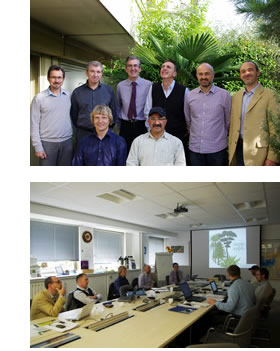
Ad hoc Meeting of the EPPO Expert Working Group
on Wood Commodities
Paris, 2014-10-07/10
 The EWG meeting took place at the EPPO headquarters in Paris. The EWG, composed of EPPO and NAPPO experts (download a list of participants ), discussed the draft document ‘The EPPO Study on non-manufactured wood commodities’ prepared by Mr Kucinskas (LT). The EWG decided to change the title of the Study to ‘The EPPO Study on wood commodities other than round wood, sawn wood and manufactured items’. It considered existing phytosanitary terms and definitions of the ISPM 5 Glossary of Phytosanitary Terms for wood commodities (e.g. ‘round wood’, ‘sawn wood’, ‘bark’, and ‘processed wood material’) and discussed classification and definitions for those wood commodities which are not covered by the Glossary. The EWG considered recommendations received on the draft document from IFQRG (International Forest Quarantine Research Group), EFSA (European Food Safety Authority) and ISO/TC 218 Timber, and decided for phytosanitary reasons to distinguish the following wood commodities other than round wood, sawn wood and manufactured items:
The EWG meeting took place at the EPPO headquarters in Paris. The EWG, composed of EPPO and NAPPO experts (download a list of participants ), discussed the draft document ‘The EPPO Study on non-manufactured wood commodities’ prepared by Mr Kucinskas (LT). The EWG decided to change the title of the Study to ‘The EPPO Study on wood commodities other than round wood, sawn wood and manufactured items’. It considered existing phytosanitary terms and definitions of the ISPM 5 Glossary of Phytosanitary Terms for wood commodities (e.g. ‘round wood’, ‘sawn wood’, ‘bark’, and ‘processed wood material’) and discussed classification and definitions for those wood commodities which are not covered by the Glossary. The EWG considered recommendations received on the draft document from IFQRG (International Forest Quarantine Research Group), EFSA (European Food Safety Authority) and ISO/TC 218 Timber, and decided for phytosanitary reasons to distinguish the following wood commodities other than round wood, sawn wood and manufactured items:
- Harvesting residues
- Processing wood residues
- Bark
- Wood chips
- Hogwood
- Processed wood material
- Post-consumer scrap wood
Following the recommendations of EFSA and ISO/TC 218 Timber, the EWG avoided the use of the term ‘waste’ or ‘wood waste’ in the Study because most wood residues at different stages of wood consumption now tend to be used for different purposes. For ‘firewood’, the EWG concluded that it refers to the final use of wood commodities, which could be any of the above mentioned commodities, or in many cases ‘round wood’.
The EWG developed definitions for those wood commodities which were missing from the Glossary and established their links with terms used in the ISO system, in the IPPC ePhyto Study and in Customs codes. For each of the identified wood commodities (and some subcategories), the EWG considered the initial material from which they derive, most common intended uses, transport practices, pests which are likely to be associated with the material and survive on/in it, and possible phytosanitary measures. The general pest risk presented by each subcategory of wood commodities of concern was assessed in a very preliminary way.
The finalised document will be sent to the EPPO Panel on Quarantine Pests for Forestry, and then for country consultation before being presented to the EPPO Working Party for Phytosanitary Regulations for approval.
